Rank on Google's first page in 3 months
Tools and Techniques to Detect Outdated Content
Aug 14, 2023 | Athira K
We find an optimal keyword, write an impeccable copy, optimize it for search engines, and publish them. But it won’t be after a minimum of one month that the blog will get traction. But as time pass by, it is possible that, at some point, content may become outdated.
It could be a stat report, best practices, or even listicles of best tools or frameworks. And together with the fact that old content pieces tend to bring in more traffic, it is crucial that you keep the content up-to-date.
A study we conducted on SuiteJar’s website revealed that around 70% of the clicks and 90% of clicks and impressions come through old blogs or content pieces [Old content in the sense, older than 3 months].
So, how can you identify them?
Surely going through each web page’s content and checking for content can be a tedious task. Don’t worry. We are here to help you.
In this blog, we discuss the importance of identifying outdated content, techniques, and tools to identify them, and of course, some best practices to help you with updating them.
Let’s get started!
Why Detecting Outdated Content is Essential?
Finding outdated content is like changing your vehicle’s oil. It had a good run, but it needs to be replaced if the vehicle is to ride further. It’s not always the most fun job, but it’s crucial.
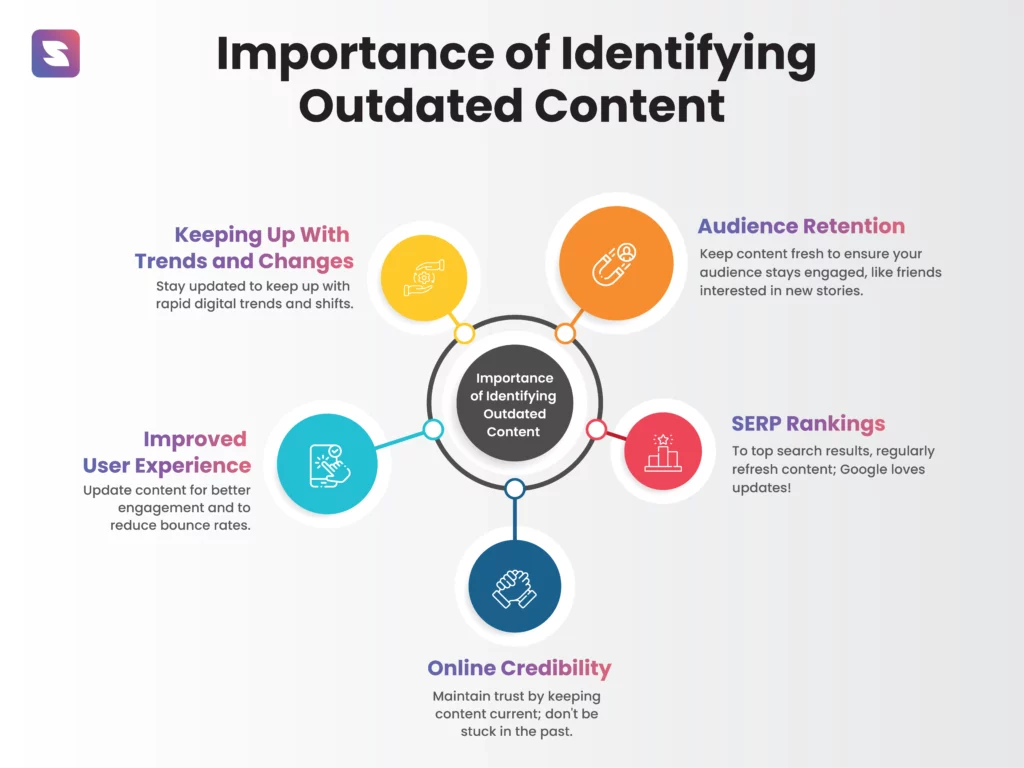
And here’s why:
I. Audience Retention
This is like keeping your friends interested in your stories. If you’re always telling the same old tale, they’re going to get bored and stop listening, right? Same thing with your audience.
They crave fresh, relevant, and interesting content. If they keep stumbling upon content on your site that’s out of date, irrelevant, or just plain wrong, they’ll lose interest. But updating your content helps ensure your audience keeps coming back for more, just like your friends at your weekly gatherings.
II. SERP Rankings
Now let’s get a bit technical but still pretty simple. SERP stands for Search Engine Results Page – it’s the list you get when you search for something on Google or any other search engine. And your aim is to be at the top of that list.
Search engines, especially Google, are super smart, and they love fresh, updated content. Here’s the new update of Google Algorithm discussing the same.
So, if your content is outdated, it’s not going to impress them. And therefore,, if you want to climb up the SERP ladder, keeping your content updated is the key.
III. Online Credibility
Imagine going to a tech blog and reading about how awesome the iPhone 4 is. You’d probably be like, “What?! Are they living in 2010?”
Your credibility goes out the window if your content is outdated. Keeping your content fresh and updated ensures that your audience sees you as a credible, trustworthy source of information. And in the digital world, credibility is everything.
IV. Improved User Experience
Old, outdated content can be frustrating for users. It can lead to higher bounce rates (when people leave your site quickly) and lower conversion rates (when people do what you want them to do on your site, like buy something, sign up for a newsletter, etc.).
By regularly updating your content, you ensure your users are getting the most accurate, relevant, and helpful information. This enhances their overall experience.
V. Keeping Up With Trends and Changes
Digital marketing trends change faster than fashion. If you don’t keep up, you’ll be left behind.
Regularly updating your content allows you to incorporate new keywords, adapt to changes in your industry, and stay ahead of your competition. This includes updating outdated SEO practices, utilizing new social media platforms, and even adjusting to changes in your audience’s behavior or preferences.
Now that we have understood the importance of updating outdated content, let’s see how we can identify them.
Techniques to Identify Outdated Content
Now picture this: You’ve got this digital closet filled with all your content pieces – blogs, articles, videos, the works. Some are your evergreen pieces that are as classic as that little black dress. Others, however, have gone out of style.
So how do you figure out which content is the equivalent of bell bottoms in the age of skinny jeans? Let’s see.
1. Trusty Old Analytics
Get cozy with tools like Google Analytics. If you see a drop in traffic to a particular piece of content that was once a hot favorite, it’s probably because it’s losing its mojo. It’s a bit like noting that one shirt you used to love but haven’t worn in ages.
2. SERP Position Dropping
Your content used to rank on the first page of Google, and now it’s on the third? Well, that’s a signal. It’s like your favorite song going down the music charts. Time for a remix!
3. The Date Check
Sometimes, it’s as simple as checking the date. If your article talks about the “latest trends of 2017,” it’s a dead giveaway that your content might need a spruce-up. Would you still be raving about a movie you watched three years ago as if it just came out? Probably not.
4. Outdated Facts and Figures
Stumbled upon a stat from 2015? That’s like finding an expired product in your fridge. Always ensure your facts, figures, and references are the latest. Fresh is best!
5. Broken Links
Nothing screams “outdated” like clicking on a link and getting an error. It’s like telling someone to check out a cool store, only to find out it closed down ages ago. Regularly check and update those links.
6. The Evolution of Best Practices
In some industries, best practices change faster than fashion trends. If your content is based on a “best practice” from years ago, double-check to ensure it’s still relevant.
7. Check the Competition
Sometimes, keeping an eye on what your competitors are doing can give you hints. If they’re all talking about a new development in your field and you’re not, it’s like everyone is wearing the latest trend while you’re still stuck in the past.
In short, identifying outdated content is a mix of detective work and staying in the know. It’s about making sure your digital closet is filled with trendy, relevant pieces that make you look good.
Now that we have discussed the manual way of finding outdated content, let’s discuss some tools to help you with this.
Tools to Identify Outdated Content
These tools are like your digital magnifying glasses, perfect for zooming in on outdated content!
1. SuiteJar: Lesser known but pretty potent!
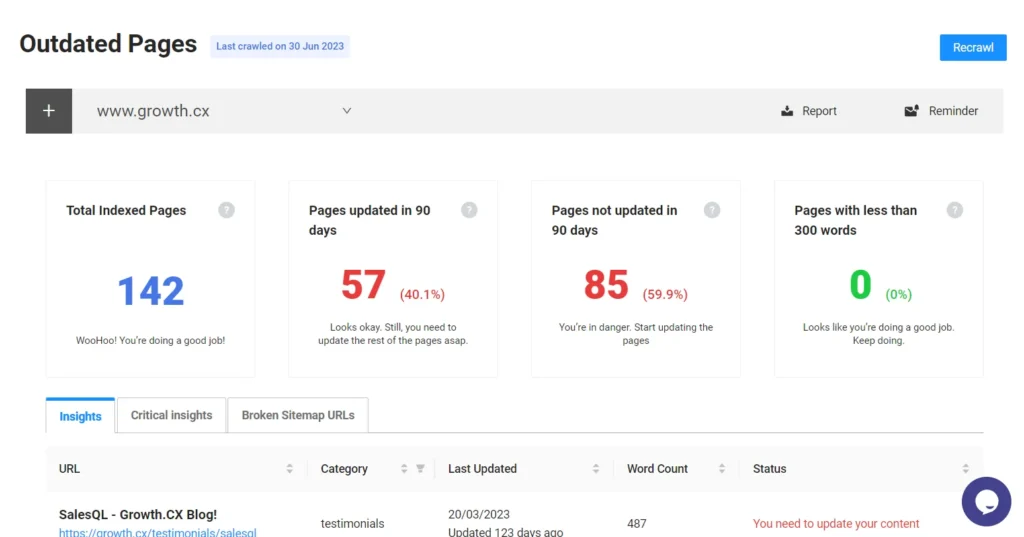
How it Works
SuiteJar is all about helping you keep your site’s content fresh and engaging. It offers various SEO tools, but for our conversation, the “Outdated Pages” feature is the star.
Spotting Outdated Content
This feature gives you a straightforward list of pages that have been gathering digital dust. By specifying a timeframe (like “not updated in the last 6 months“), you get a list of potential content pieces that might need a refresh.
Bonus Tip
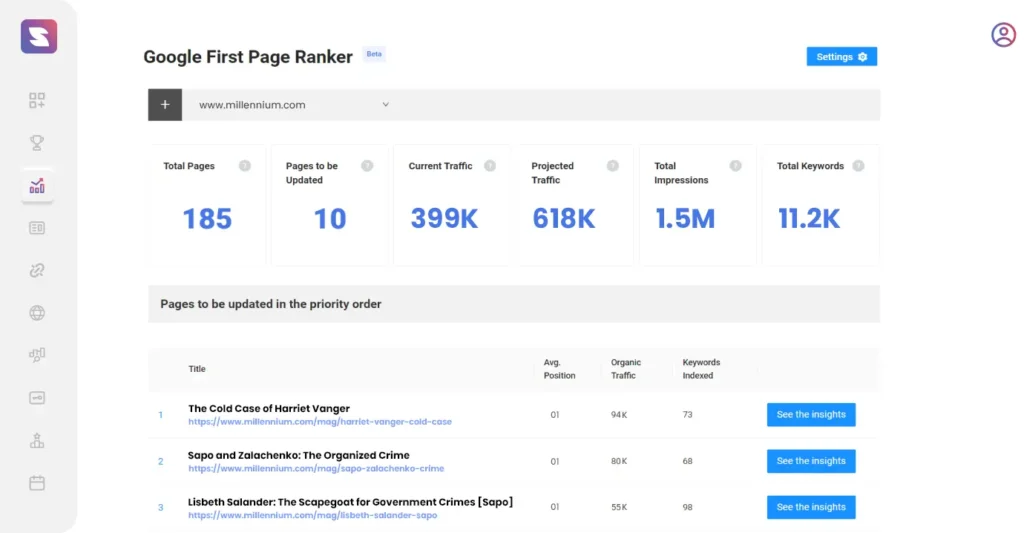
SuiteJar, like the other SEO tools, can provide insights into traffic and performance metrics. It offers a new and one-of-a-kind feature called “First Page Ranker”.
It helps you identify all old content pieces that have the most potential to rank and offer insight into how to achieve it. Its actionable insights include the keyword to add, broken links to fix, alt tags to add, and more.
2. Google Search Console (GSC): A free tool and a gift from Google to website owners!
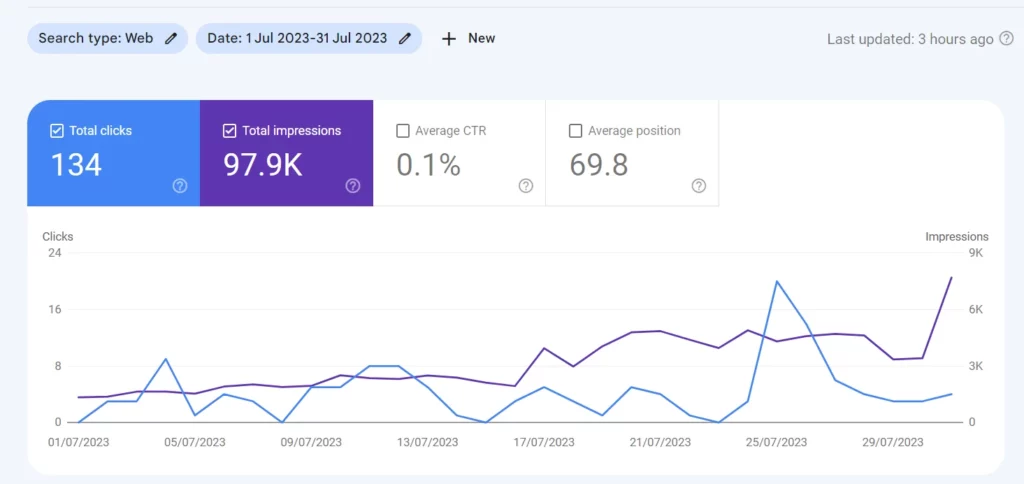
How it Works
GSC allows you to get a peek into how Google views your site. And one of its coolest features is showing you how your content performs over time.
Spotting Outdated Content
The “Pages” report is like the crystal ball of your website’s performance. If a once-popular page’s traffic has dwindled, that’s a red flag. Also, look out for increased crawl errors or pages that Google has trouble accessing – these might contain old content or structures.
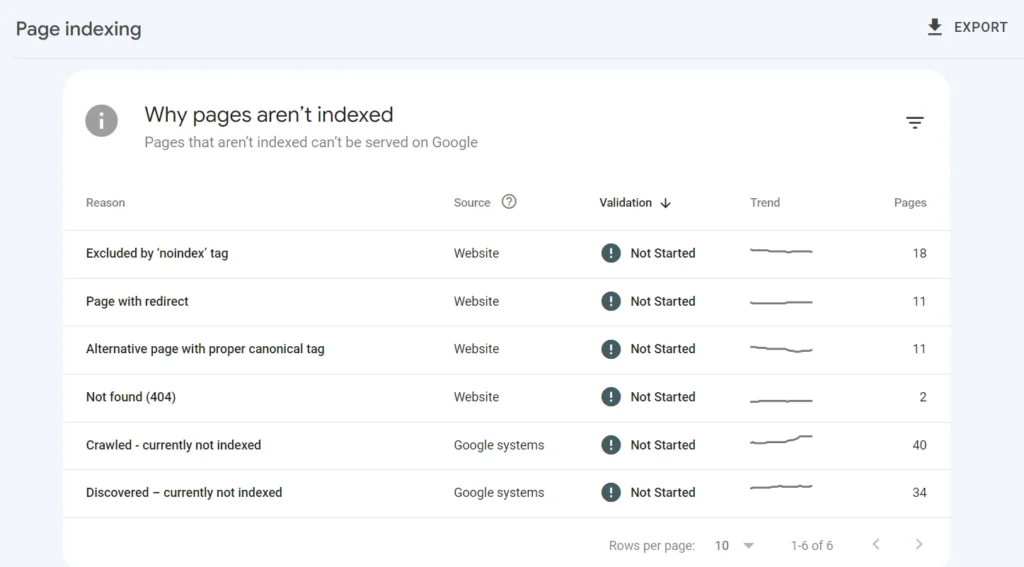
Pages with the above-mentioned issues can be easily attended to. But for others, you will need to filter the impressions and clicks, compare the data with the previous, and so on until you find which blogs need updating.
Bonus Tip
Check out the “Search Results” report too. If the click-through rate (CTR) drops for a specific piece of content, it might be losing its appeal or relevance.
3. SEMrush: One of the big guns in the SEO world

How it Works:
SEMrush helps you with everything SEO-related, from keyword research to backlink analysis. But let’s focus on our mission: detecting outdated content.
Spotting Outdated Content:
The “Content Audit” evaluates your content’s performance and flags pages that might need a revisit. The tool can highlight pages that haven’t been updated in a while or those that aren’t getting any love (aka backlinks) from other sites.
Bonus Tip
SEMrush also allows you to track position changes for keywords. If one of your top-performing keywords starts to slip in rankings, the content associated with it might need an update.
Though SEMrush offers such features, its expensive pricing makes it harder for marketers to choose it. Here are some affordable SEMrush alternatives for you to check on.
Keeping an eye on any downward trends can be your early warning system for outdated content.
Best Practices for Updating Outdated Content
Once you’ve identified outdated content, it’s time to update or remove them. If you find any content that needs to be deleted, then follow the link to learn how to remove outdated content.
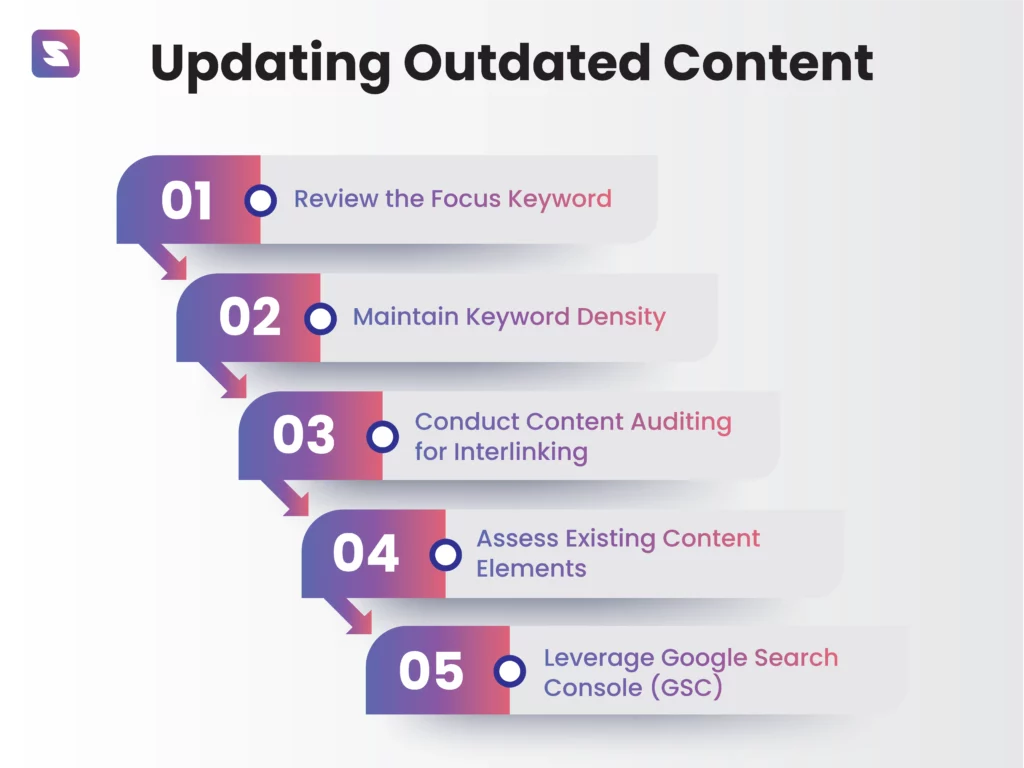
If you are looking to update the content, the following are some best practices to consider.
Best Practice 1 – Review the Focus Keyword
- Relevance: Ensure the chosen keyword aligns with the content’s main intent.
- Research: If the old focus keyword no longer aligns, conduct thorough keyword research to identify a more relevant one.
- Application: Once the keyword is established, it should naturally fit into the content.
Best Practice 2 – Maintain Keyword Density
- Placement: Include the keyword in the introduction, conclusion, headers, main body, and alt text.
- Natural Integration: Aim for a natural flow rather than forced stuffing. Always prioritize reader experience over keyword density.
Best Practice 3 – Conduct Content Auditing for Interlinking
- Holistic View: Understand what other content pieces you have that relate to the topic.
- Variety: Look for various types of content – blogs, how-to guides, eBooks, comparison articles, and service pages.
- Purpose: Interlinking helps in guiding the reader to more relevant content and also for SEO benefits.
Best Practice 4 – Assess Existing Content Elements
- Competitor Analysis: Understand what elements competitors use to engage their audience.
- Content Add-ons: Use images, CTAs, and structured content to enhance reader engagement and comprehension.
- Targeting: Ensure the content matches the conversion intent, e.g., don’t overflow a top-of-the-funnel topic with CTAs.
Best Practice 5 – Leverage Google Search Console (GSC)
- Data-Driven Insights: Use GSC to understand which queries drive traffic or impressions to the old content.
- Optimization: Tailor your content update around high-performing queries to improve relevance and performance.
Learn everything about updating old content pieces.
Conclusion
Do regular content audits and keep a keen eye for industry trends to ensure that your content remains relevant. And with the ever-changing landscape, this is rather an inevitable process to adopt.
Make use of the techniques we have discussed and also the tools to identify outdated content for effectiveness.
Equipped with the right techniques and tools, you can identify outdated content pieces quickly and tend to them. Removing or updating outdated content depends on whether the content is relevant to your business goal or not.
